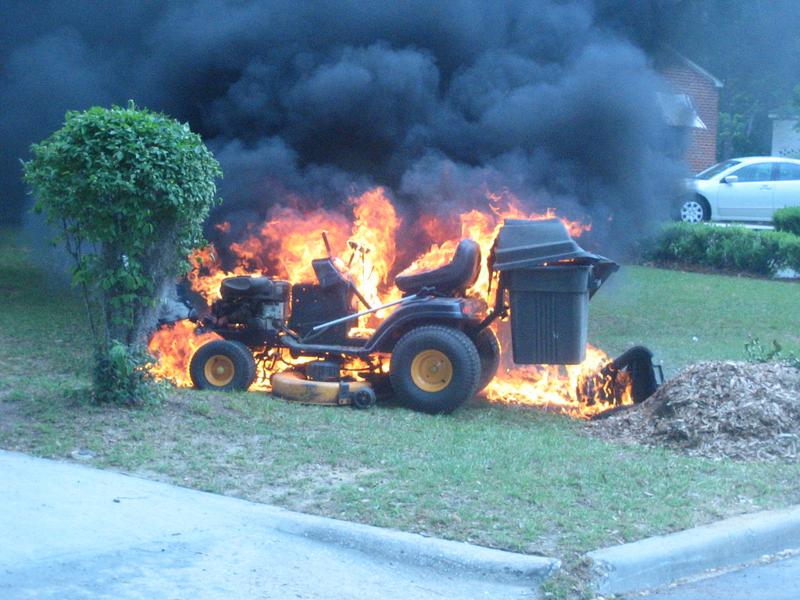The first working internal combustion engine was invented in the mid-19th century, and since then, the technology has gotten even better. From giant machines that dig through mountains to the smaller ones that power your lawn care equipment, so much of the world runs off the power of gasoline and spark plugs. However, when just a small part of the hundred processes that make these engines go wrong, the entire thing can go kaput.
Unfortunately, that's a problem that many do-it-yourselfers experience when they try to cut corners and skimp on less expensive but poorly designed lawn care equipment. Even the best-made engines need regular maintenance if you plan on pushing them hard, and missing a cup of oil here or a dash of fuel stabilizer there can have big consequences down the road. If you've noticed your lawn mower slowing down the last few times you've taken it out in the yard, it might be time to start thinking about upgrading to a long-lasting Husqvarna model. If not, check out these three sure-fire signs that your mower's engine is ready to be put out to pasture.
 If your mower looks like this, it is, unfortunately, dead.
If your mower looks like this, it is, unfortunately, dead.1. It runs for a few seconds or minutes, then dies.
With the perfect amount of maintenance and fuel, a well-constructed engine should be able to run for years. Take any of those elements away, and you have the formula for a mower that can start just fine, but doesn't have what it takes to run for more than a few moments. After sputtering to life, it might burp out a few puffs of smoke or just rumble itself to a halt.
What gives here? A common culprit actually has to do with the fuel that runs through the engine rather than the machinery itself. If you mow your lawn intermittently and don't worry too much about cycling out old gasoline for fresh stuff, you run the risk of this fluid breaking down. Without adding fuel stabilizer to keep it fresh, common ethanols can solidify into a viscous, stiff liquid similar to varnish. If you let this mixture seep into the hundreds of chambers and pipes that make up even the smallest of engines, it could seize the entire thing up.
You could go all out and try to give your carburetor a deep clean with expensive products targeted at breaking up this hardened fuel composite, but there's no guarantee you'll be able to get to every nook and cranny that you need to clear for your mower to run right again.
2. It's not too hot to touch – it's too hot to go near.
It's a simple fact: Engines produce heat. After all, they have "combustion" in the name for a reason. By igniting volatile fuel stores, the pressure from those tiny explosions creates mechanical force, and most well-designed mowers have ways of dissipating the heat that often mounts to dangerous degrees.
"The more heat the engine has to deal with, the greater the chance of catastrophic damage."
Obviously, you should never go near a bare engine right after it's been running for a while, but if your mower is showing signs of severe overheating, it might be time to consider your options. Any sign of smoke or steam – even if the mower continues to run – should be taken as an indication that your engine isn't relieving itself of heat buildup as efficiently as it should. This might be due to a lack of lubrication or just too much wear from old age, but regardless, the more heat the engine has to deal with, the greater the chance of catastrophic damage.
An extra cup of motor oil might sound like good advice, but it won't do much if your engine burns it right up.
3. It slows or chugs in tall, thick grass.
Not all mowers are created equal, and if you regularly mow patches of grass that grow long, tall and thick, you're going to need a powerful machine from Husqvarna to get you through the brush. But if you notice your once-speedy machine slowing down as you take it over denser patches of grass, it could be a sign of an aging engine.
At startup, your engine only needs to create enough power to turn the mower blades and edge the machine's wheels forward – a comparatively small amount. When you start to take it over patches of thick grass, you're instantly compounding the force the engine must create. Think of how strong a bundle of sticks tied together is compared to just a single twig. That's what your mower is facing when you drive it over dense growths.
What causes this? It could be any number of defects that sap your engine of energy, but more likely it's just the old age of the mower and another sign that it'll be pushing up mechanical daisies sooner than later.
There are other signs – oil leaks and high spark plug turnover rate to name a few – that you should ditch your dying mower for an efficiently designed model from Husqvarna. However, if you see any of these in your regular course of lawn maintenance, you're better off getting ahead of the problem, junking your beat up mower and treating yourself and your lawn to a better class of lawn care equipment before you're left with none at all.